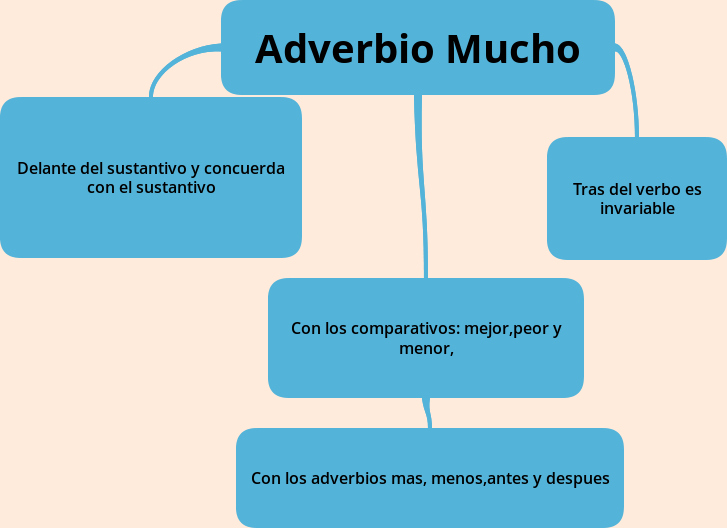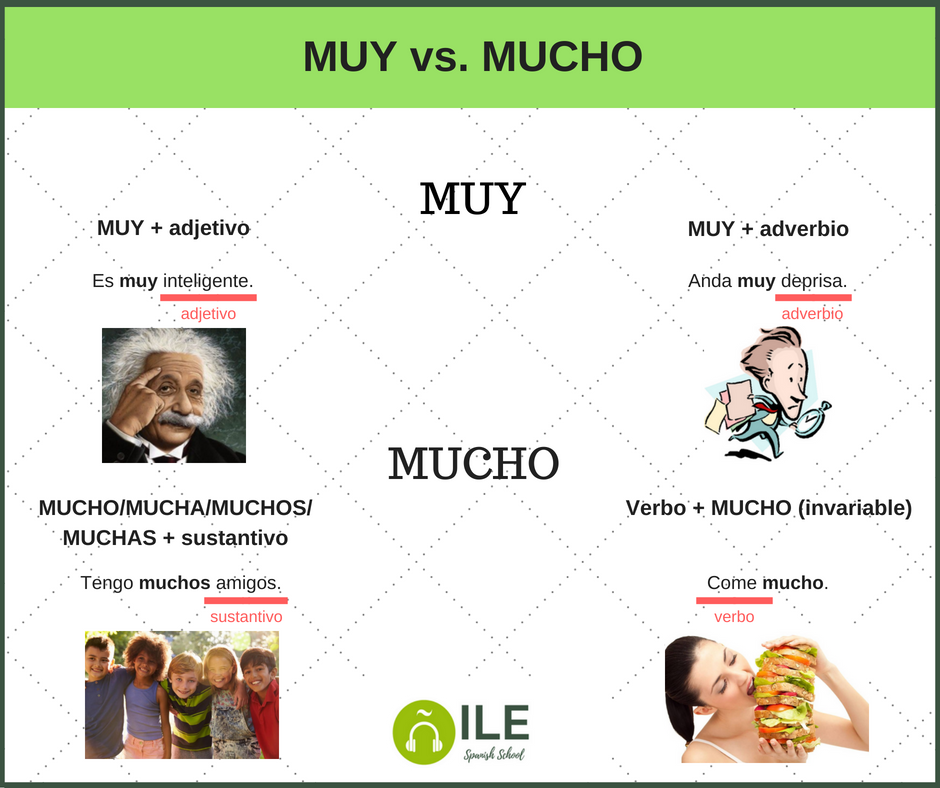
Diferencia entre muy y mucho en español Spanishminute
Es importante tener en cuenta que muy sólo se utiliza para modificar adjetivos o adverbios, y no para sustituir un verbo. Por ejemplo, no es correcto decir " yo muy estudio español ". Muy sirve como la forma apocopada de mucho cuando precede a un adjetivo o a un adverbio. A excepción de los comparativos: mejor, peor, mayor, menor, más.

9 best Differences between muy and mucho (Diferencias entre "muy" y "mucho") images on Pinterest
What is the difference between mucho and muy? Compare and contrast the definitions and English translations of mucho and muy on SpanishDictionary.com, the world's most accurate Spanish-English reference website.. La casa de Marta es muy grande. - Sí, es enorme. Marta's house is really big. - Yes, it's huge. 2. (excessively) a. too. Es muy.

Muy E Mucho Exercícios
Muy: an adverb. Muy is an adverb, and is the direct translation of very in Spanish.Just like any adverb, muy in Spanish can modify an adjective or another adverb.Like its English counterpart, muy in Spanish is used to intensify the qualities or characteristics of people or things. For a thorough overview of adverbs in general, take a look at our dedicated post on Spanish adverbs.

Expresiones de cantidad en español muy y mucho Spanish Via Skype
When Mucho is used as an adjective, it must agree both in gender (masc/fem) and number (singular/plural) with the noun. There are 4 ways of writing Mucho: mucho - singular masculine - (a lot, a lot of, much) mucha - singular feminine - (a lot, a lot of, much) muchos - plural masculine - (a lot, a lot of, many)

Diferencias Entre Muy Y Mucho Adjetivo Adverbios Sustantivo Images Images
Utilizamos muy con ADJETIVOS y ADVERBIOS excepto para:Los adjetivos: mejor, peor, mayor y menor. Los adverbios : más, menos, antes y después. Ejemplo : Soy mucho más guapo que mi hermano.

Muy o Mucho? La diferencia! Ejercicios de español, Español, Adjetivos
There's no hurry. Mucho. is slightly more complex than as it can be both an adjective and an adverb. It combines with different parts of speech. in English is "a lot", "a lot of", "much", and "many": Mucho + Noun. When is followed by a noun, it is an adjective, it must agree in gender and number with the noun it follows.

Diferencia entre “muy” y “mucho” Superseñorita Learning spanish
📚 Aprende más español en mi Zona Premium: https://bit.ly/3oEcONp**** SUBTÍTULOS DISPONIBLES EN ESPAÑOL ****Aprender español: Muy, mucho y poco (nivel básico.

Différences entre "Muy et Mucho" Ecole Cervantes
Ej. Esta casa es mucho mejor que la nuestra. Nota: En este caso, "MUCHO" es invariable, es decir, siempre va en masculino singular, y se sitúa delante del adverbio. 4. Resumen de la diferencia entre MUY y MUCHO. Como puedes ver, MUY se usa con adjetivos y adverbios, y MUCHO (o MUCHO/A , MUCHOS/AS) se usa con verbos, sustantivos y adverbios.

Muy vs Mucho Spanish Help, Spanish Lessons For Kids, Spanish Teacher, Spanish Language, Junior
Ejercicio de gramática en español de nivel A1/A2: ¿Muy o mucho? Español esencial - Completa correctamente. Estoy. contenta en mi nuevo trabajo., Te q.

¿Muy o mucho? La página del español
Muy vs Mucho (Una explicación en español) Once you have learned these rules, you should try the following game: Muy vs Mucho Juego/Game. There is also another new game about the difference between Mucho, Muchos, Mucha, Muchas. Below is a summary chart: Remember to share this if you like it or find it useful. Shares.

La diferencia entre MUY y MUCHO en castellano. En castellano, Castellano, Gramática
Muy vs Mucho: Key Differences Explained (+ Examples) Muy means 'very'. It intensifies the qualities described by an adjective or another adverb. Mucho is the equivalent of 'a lot' or 'very much', and it conveys the intensity or degree of an action. Unlike muy, mucho can also express the amount of something.

Learn Spanish/Aprende Español Online Las diferencias entre Muy y Mucho
Primer uso: En el primer caso, «muy» se utiliza delante de adjetivos. Muy modifica adjetivos como interesante, grande, alto, sucio, trabajador, elegante o entusiasta, por ponerte solo unos ejemplos. "Yo soy muy responsable". "Tú eres muy agradable". Segundo uso: En el otro caso, "muy" se utiliza delante de adverbios.

Nivel A1 AIL Madrid
Explicación y actividades para aprender la diferencia entre los adverbios "muy" y "mucho" en nivel A1. Incluye test de 100 preguntas. Tareas: 12. Explicación.. Cuando dice "Corro rapidísimo", la verdad es que corre muy rápido. Lee las frases de Juan y cambia los adjetivos por su forma con muy. Di tu respuesta en voz alta. Mucho.

Cuándo Usar Muy y Mucho
Difference between Spanish muy and mucho | En este vídeo vamos a ver la diferencia entre muy y mucho. Primero mira el vídeo y después haz los ejercicios en n.

MUY vs. MUCHO
Como mucho e muy possuem o mesmo significado (muito), a diferença entre o uso de cada um é estabelecida pela função gramatical das palavras que os cercam. Ou seja: Mucho: usado antes de substantivos, depois de verbos e antes dos seguintes advérbios: antes, después, menor, mayor, mejor e peor. Muy: usado antes de adjetivos, advérbios e.

Muy vs Mucho Palavras em espanhol, Vocabulário espanhol, Aprender espanhol
Ella camina muy rápido. She walks very quickly. (rápido = adverbio) On the other hand, mucho is an adjective, so it must agree in number and gender to the noun it modifies. Los estudiantes tienen mucha tarea. The students have a lot of homework. Yo como muchas frutas. I eat a lot of fruits. Tú tienes mucho sue-alunamaño porque has trabajado.
- Convención Sobre Armas Biológicas Y Toxínicas
- Convención Europea De Los Derechos Del Hombre
- Ciudad Del Cabo En Ingles
- Amateur Real Blow Job Cideo
- Solicitar Beca General Mec 2023 24
- 420bate Taste My Hole 420bate Animated Gif
- Como Saber A Que Clase Social Pertenezco España
- Planta Medicinal Para Dormir Bien
- Que Beneficio Tiene El Huevo Crudo
- No Te Ibas A Ir
